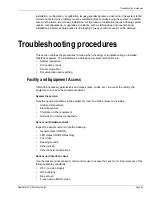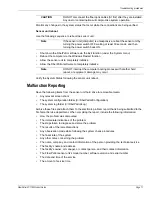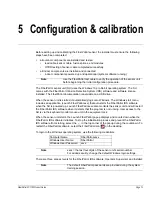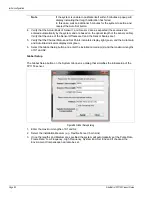
System Diagnostics
FiberPatrol FP1150 Product Guide
Page 67
System Diagnostics
The FiberPatrol software monitors the FiberPatrol system for any operational issues or component
malfunctions. System self-diagnostics can detect and report the following conditions:
•
Sensor cable or lead cable damage
•
Loss of optical connections to sensor unit
•
Failure of certain optical or electronic components in sensor unit
•
Malfunction of data acquisition card in sensor unit
The following conditions cannot be self-diagnosed
•
Sensor unit malfunction or crash
•
Operating system and software driver errors
•
FiberPatrol software interface crash
Some conditions resulting from incorrect or improper system installation, configuration, or
calibration may also not be detectable by system self-diagnostics.
System Status Reporting
When FiberPatrol software detects an error condition, it alerts local and remote operators by
reporting the corresponding System Status and generating Head End alarms. The System Status
indicator in the lower left corner of the FiberPatrol software interface can show four general states:
•
Armed - normal operation
•
Cable Cut - sensor cable cut
•
Warning - non-critical failure, intrusion detection still possible
•
Disarmed - critical failure that disables the system (no detection)
Head End alarms are generated and reported when the general system status changes to
Disarmed. Head End alarms are treated by the FiberPatrol system the same way intrusion alarms
are. By default, they are reported with a location of -1000 and zone label HeadEnd, and are
displayed on the map at the point where the system’s electronic equipment is located. Head End
alarms can be cleared. However, clearing a Head End alarm does not fix the underlying problem.
Even if the current system status is Armed, recent Head End alarms may indicate a recurrent
system problem that needs to be addressed.
Remote Systems
For a system located at a remote site and monitored via a network, the following could be signs of
a system malfunction:
•
Remote connection is dropped or was not established
•
Unit status alarm is received from the remote system
•
Unit Disarmed status is reported
If a remote connection is active, using a remote desktop application to connect to the FiberPatrol
sensor unit can be an effective way to troubleshoot the system.
If it is impossible to establish a remote connection to any of the equipment at the remote site, then
it is likely to be a network issue, which should be referred to IT personnel.






























